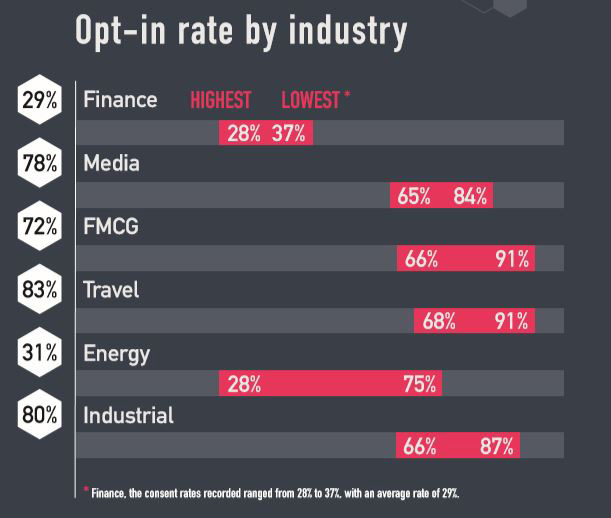What strategies are available to improve the opt-in rate?
11/02/2020 |

The consent issue will long be a fixture on the to-do list for marketing directors. What is the course of action? Although some professionals are tempted to use tactics to bypass the issue, others are taking a more strategic approach.
On the ground level
The short-term reflex: the temptation to circumvent
Although the opt-in is valid for 13 months (in other words, a legitimately accepted cookie may have such a lifecycle), legislation currently fails to mention anything about the opt-out validity period. That is all it took for organisations to see an opportunity, namely to ask for consent from visitors who have already opted out whenever they visit the site. Or how to invent the digital era’s very own version of nuisance calling…
This is not the only tactic that bypass fans are resorting to. For example, they can opt for a paginated display of the different cookie categories in an attempt to bore visitors and encourage them to accept everything as quickly as possible. In our eyes, this behaviour is akin to a headlong rush that is not only ineffective but capable of harming the company’s brand image. Consent collection practices are evidently one of the criteria for assessing how much (or how little) trust can be placed in a brand. There is also the danger of underestimating the “consent culture” that will progressively spread among the community of web users. Users will not be fooled by these tactics for long.
The long-term investment: the return of the login and authentication method
Many brands are shying away from such circumvention tactics and have instead opted to overhaul their digital strategy by incorporating consent collection and management. That explains why login screens are popping back up on websites, even those without a transaction space (an e-commerce account, for example). Better still, alliances are being forged in various sectors of activity to give users a single login for several different brands and websites. Media groups in particular are at the leading edge of this movement. For instance, Le Geste, a French association of online editors, is working with a dozen media outlets to roll out a single login system. Login and privacy initiatives are also cropping up in Germany (where Axel Springer is fiercely against the platforms) and Portugal.
In fact, letting users sign in and access content and services offers a number of advantages. Although the login method does not eliminate the need to obtain consent when using cookies for guest users, it allows for a two-speed system, such as by using few cookies for anonymous visitors (which simplifies the opt-in screen) and taking a more detailed approach for authenticated visitors. Logging in gives identified users the opportunity to fine-tune the terms of the “contract” and how their data are used.
Another upside to the login system is that by maintaining a user session, it can compensate for the mechanisms that reduce the cookies’ scope of action, as we saw earlier. In addition, a direct connection with the audience is an effective way of fleshing out the company’s first-party data. This concern is clearly a trending issue…
The essentials
Work on how consent is worded
Or how to restore collaboration between marketing and legal departments
Whether or not opting for a login system, a new form of collaboration would be desirable between the marketing and legal teams. As it currently stands, the legal team has too often been lumbered with the job of wording consent, probably based on the idea that just like the standard terms and conditions of sale, nobody will bother spending too much time poring over these few lines.
This attitude is easily understandable, given that consent rates hover around the 90% mark when organisations go for the soft opt-in approach. But as we have seen, the situation will have changed by July 2020, insofar as users will need to take an affirmative action to give their consent. It will take more than a purely legal text to motivate users to do so. The contract formed when collecting consent must now be developed by both the legal and marketing teams to garner support from users. The aim is to use the clearest possible language to describe the value of their consent and the brand’s commitments. Each organisation needs to find its own wording…
Migrating from consent management to preference management
Or how to turn consent into a user experience
Since consent is no longer a matter of asking web users to nod their head in front of a screen of pre-ticked boxes, it would seem logical to look at the collection process as an integral part of the user experience, not something that should merely be used to obtain consent, but also to give visitors the possibility of defining all their preferences. Do they agree to receive web push notifications? Do they want to see ads on social networks? Do they want to receive an email summarising the latest news? How often?
It can be seen with these examples that managing preferences can be especially exhaustive and “useful” if users are logged in. In any case, the way ahead seems to be all mapped out with privacy centres (the page where users can see their consents) turning into preference centres. A preference centre is a place where all visitors have an insight into their touchpoints and the information that they have agreed or refused to share. It is also a place where users do not typically venture, but merely to control their relationship with the brand.
Create a consent scenario
Or how to boost collaboration between marketing and martech
Since soft consent is a thing of the past, each organisation needs to get ready to offer a much more explicit form of consent collection, while bracing itself for a significant fall in the opt-in rate. But to what extent? The latest edition of the Commanders Act Privacy Barometer offers a number of clues.
Close to 32% of the sites in the study cling to a super-soft form of opt-in (consent is validated as soon as users scroll or click on an element) and 31% maintain a soft opt-in approach (consent is validated when users visit a second page). That is why the consent rate in such industries as “Fashion & Retail” and “Travel” fluctuate between 66% and 91%! These rates are in strong contrast to the finance sector, which tends to follow a strict consent approach (explicitly clicking on an Agree button) and which has an average opt-in rate of… 29%. That figure provides a glimpse of what website editors can expect with the end of the soft consent tactic.
With opt-in rates reduced by a third or half, creating consent scenarios is becoming a real issue. There are no taboo questions. Should we ask for consent on the first page visited? If users opt out, should we ask them the same question each time they visit the site? If they give partial consent, can we really chase them up? In practice, there is every likelihood that the process of collecting and completing consent will gradually gravitate towards marketing automation with conditioned scenarios and testing. A fully-fledged discipline? In any case, it is an area where each organisation will need to develop its experience.
Supervise consent
Or how to get equipped for taking action
Because it is part of the user experience and because it determines the ability to build customer intimacy and activate digital strategies, the consent collection process requires accurate tracking with dedicated KPIs (Key Performance Indicators), and rightly so, since plenty of questions marks are raised:
- What is the global opt-in rate?
- How are opt-ins divided between categories (analytics, retargeting, emailing, etc.)?
- What about between the different screens and messages proposed? Which ones are the best at converting?
- How much traffic is flowing to the Privacy Centre?
These invaluable data can be leveraged to continually improve the consent process and fine-tune the contract of trust with the audience.

Find out more about our CMP
Takeaway
Since consent is going to be around for a long time, circumvention attempts are doomed to failure. It is in brands’ best interests to transform consent into an integral part of the user experience. For a successful consent process, close collaboration is required between the legal, technical and marketing teams.











